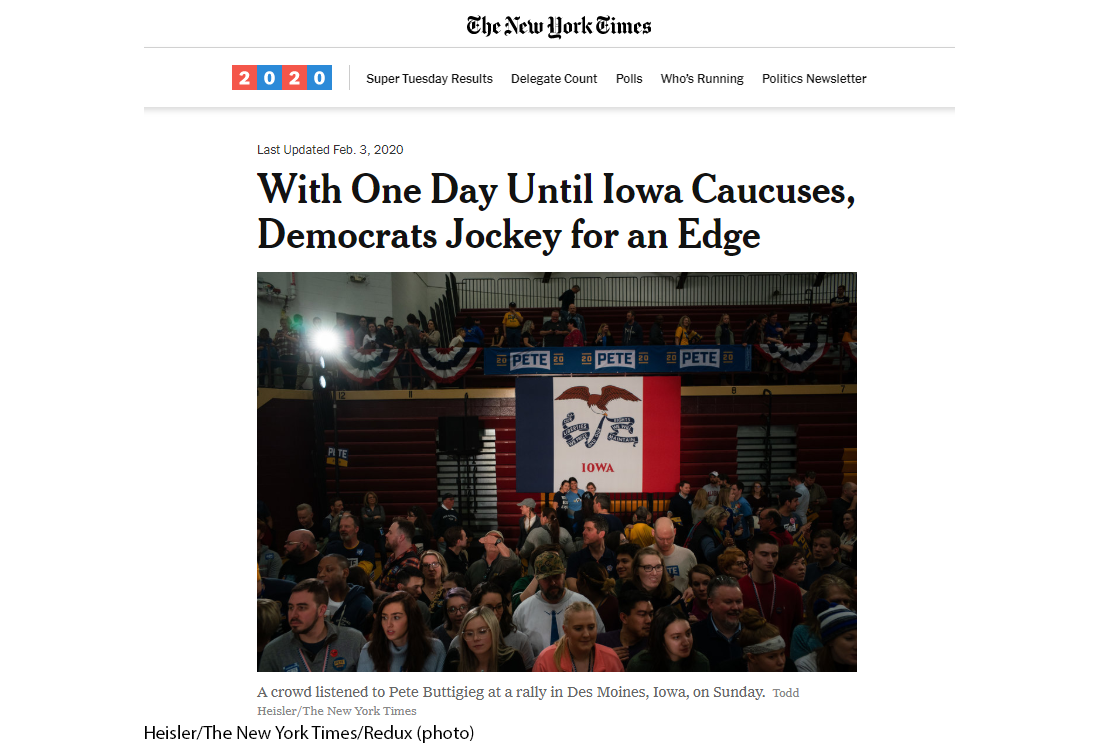Problems of Traditional News Media Coverage
Horse-Race Coverage
Since the news media began conducting their own election polls in the 1970s, journalism has often reverted to “horse-race” coverage—who’s in the lead, who’s falling behind, and who’s gaining momentum.4 That’s the story that the news media was ready to tell on the night of the Iowa caucuses. Even CNN’s Chris Cuomo referred to the “big bets” candidates put on Iowa, making it sound like a wager at the Kentucky Derby. Terms like “dark horse” (a little-known horse that makes an unexpected first-place or high finish) also abound in election coverage. Try this: Google a candidate’s name and the term “dark horse.” Candidates like Buttigieg and Klobuchar got the title frequently, but candidates with higher poll numbers and media expectations—like Biden, Sanders, and Warren—were rarely identified that way.
The problem with horse-race coverage, according to the Encyclopedia of Political Communication, is that it “does little to inform and educate voters about domestic or foreign issues or policy issues that might directly affect the voters. Instead, such horse-race coverage tends to focus on the candidates and members of political parties as if they were celebrities, sports figures, or game show participants who are in a race or contest instead of a political campaign to hold public office and serve a constituency.”5
False Equivalence
In order to avoid seeming partisan, or in an effort to seem fair and balanced, the news media at times will resort to reporting things as equivalent when they are not. The classic example of our times is climate change. The consensus of 97 percent of scientists in thousands of research papers is that recent global warming is caused by humans.6 It would be absurd to suggest that this is a debate in which “both sides” are equal. In fact, the “other” side—which has sown distrust in scientific conclusions—is funded by the fossil fuel industries, which have great financial interest in doing so.6
The same false equivalence can occur in political and election coverage. For example, a study by the Harvard Kennedy School’s Shorenstein Center on Media, Politics and Public Policy found that in the news reports in the 2016 presidential campaign, “[Hillary] Clinton and [Donald] Trump’s coverage was virtually identical in terms of its negative tone.” The study’s lead author, Thomas E. Patterson, asked, “Were the allegations surrounding Clinton of the same order of magnitude as those surrounding Trump?” In this example, the news media treated Clinton’s use of the same computer server for her personal and official e-mails just as negatively as the recorded disclosure of Trump bragging about groping women without their consent, saying, “When you’re a star, they let you do it.” Patterson concluded that the news media were not cautious enough about the potential of false equivalence in their reporting. “It’s a question that political reporters made no serious effort to answer during the 2016 campaign.”8
The answer, of course, is not for the news media to give all sides of an issue equal time, space, and value—leaving the hard work of sorting through the information to citizens. Instead, journalists should evaluate and verify the information in their reports, thereby giving greater value to the news.

4Thomas Patterson, The Mass Media Election (New York: Praeger, 1980).
5Lynda Lee Kaid and Christina Holtz-Bacha, eds., Encyclopedia of Political Communication (Los Angeles: SAGE, 2008), 310.
6John Cook et al., “Consensus on Consensus: A Synthesis of Consensus Estimates on Human-Caused Global Warming, ”Environmental Research Letters 11, no. 4 (2016), https://doi.org/10.1088/1748-9326/11/4/048002.
7Amy Westervelt, “How the Fossil Fuel Industry Got the Media to Think Climate Change Was Debatable,” Washington Post, January 10, 2019, www.washingtonpost.com/outlook/2019/01/10/how-fossil-fuel-industry-got-media-think-climate-change-was-debatable.
8Thomas E. Patterson, “News Coverage of the 2016 General Election: How the Press Failed the Voters,” Shorenstein Center on Media, Politics and Public Policy, December 7, 2016, https://shorensteincenter.org/news-coverage-2016-general-election.